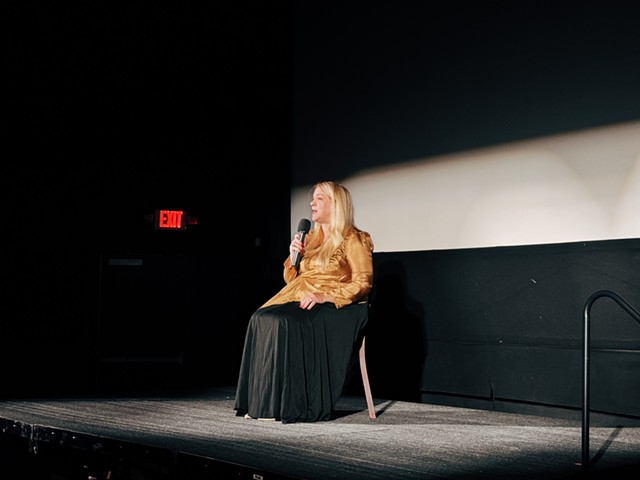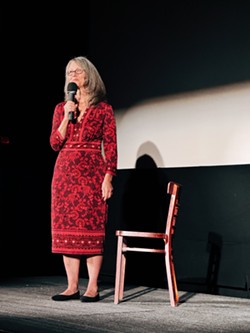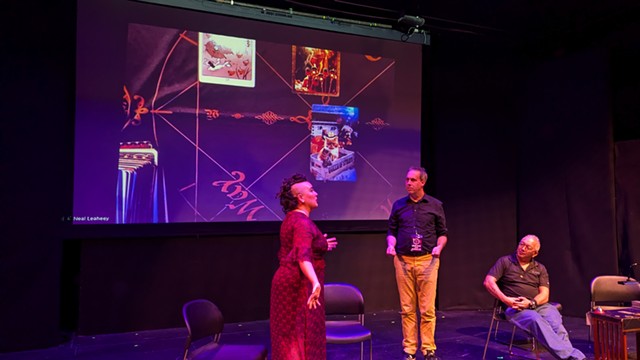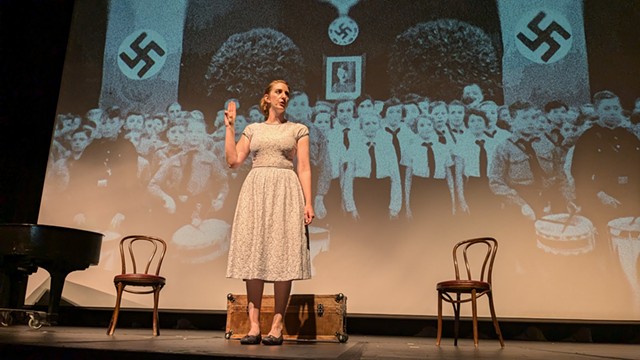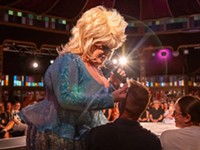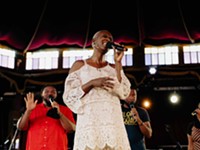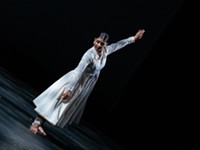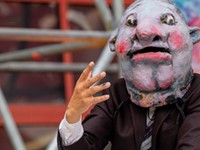[
{
"name": "500x250 Ad",
"insertPoint": "5",
"component": "15667920",
"parentWrapperClass": "",
"requiredCountToDisplay": "1"
}
]
Unhappy ending
“That Woman” | ROC Cinema | Saturday, Sept. 20 | $15 | 16+
A German cocktail waitress. A burlesque dancer. A 19-year-old White House intern. A divorcee who tragically lost her son. A socialite who mingled with the mob.
These non-fictional characters are united in “That Woman,” monologues from the perspectives of women involved with President John F. Kennedy.
And that list doesn’t even include Marilyn Monroe — or the many others who never spoke up.
After 60 minutes and six monologues, it’s easy to see how a serial womanizer charmed an entire nation. “You wanna talk about charm? He was a human magnet,” said Judith Exner (played by Elizabeth Saunders), who was the first woman to admit her involvement with the president. “He said all the right things. He made everything look so easy.”
But more than charm, JFK — “Jack” to many of his lovers — had cleverness, and an army of support behind him to ensure his womanizing ways ultimately never interfered with his political career. His biggest supporter of a decade was, of course, his wife, Jacqueline Kennedy Onassis (played by Joanna Brokaw). Her monologue comes last in the show, after her character has introduced all the others, and it’s delivered not to an audience-at-large, but to one person (though it’s unclear exactly who). It’s a fleeting look at the woman who shared a loveless marriage with JFK as he fraternized with others, and instead won over the hearts of the American people. “Emotion is the one thing a well-bred lady cannot afford,” she says.
“That Woman” is a touring production with roots in Nashville, where co-creator Molly Breen hails from originally. She is listed as co-creator/producer/playwright/Mimi Alford/Director 2024 Fringe Festivals for “That Woman” as well as director of the Tennessee Playwrights Studio, which produced the show. Breen is also the sole non-local actor in this production — given her deep ties to the work, it’s no surprise her performance was the strongest of the evening.
ROC Cinema’s restraints (such as a large handheld mic and a squeaky wooden chair) seem to limit the movement of the women onstage, and while the monologues are interesting, they could do with a little more physical engagement or visual change, especially in the case of those who stayed seated or held copies of their script. —LEAH STACY
In the cards
“Whatever Fate Decides” | SOTA: Black Box Theatre | Sept. 14 | $10 | Ages 18+
The concept of “Whatever Fate Decides” was, first and foremost, novel. The performance was half-tarot reading, half-improvised theater. The performers Neal Leaheey and Rhiannon Griswold-Jenkins invited a guest, whom they had just met earlier that day, to be the subject of a live tarot reading. Leaheey and Griswold-Jenkins then created dramatic scenes based on the reading and feedback provided by the subject.
This, in itself, was an experimental premise for a performance, but perhaps the most subversive aspect of “Whatever Fate Decides” was that the intended audience was not the people watching the performance, but rather the subject of the tarot reading.
That individual was Jack, a School of the Arts teacher and martial artist who is about to enter retirement. What followed was a genuine and intimate conversation between the performers and Jack, in which he told them the insight he wanted to gain from the reading — commentary on his life thus far and the extent to which someone from his past was affecting his present.
In the improvised scenes, Leaheey and Griswold-Jenkins reflected Jack’s interpretation of the reading back to him, taking his feedback and changing the scene accordingly, on the fly. This made the theater itself somewhat disjointed at times, and it seemed limiting to always cross-reference the improvisations with Jack’s actual life, rather than simply using it as an inspirational starting-point for whatever might follow. As a result, the dialogue felt somewhat stilted. It also would have been helpful for Jack to have been mic’d, since it was sometimes difficult to understand the extent to which the readings resonated with him.
The improvised scenes inevitably took a sentimental tone and the chemistry between Leaheey and Griswold-Jenkins didn’t have the crackling pace of a typical “Yes, and…” approach to improv. Sometimes, it felt forced.
But where it counted, “Whatever Fate Decides” was effective. The performers connected more with the reading than the actual audience, but that was always the point. That back-and-forth between the performers and Jack became the real improvised performance, and the simulated scenes merely the premise for facilitating the conversation. —DANIEL J. KUSHNER
The cost of war
“Eleanor’s Story: An American Girl in Germany” | JCC CenterStage | Sept. 14, 15 | $15-$22 | Ages 13+
As the title suggests, “Eleanor’s Story: An American Girl in Hitler’s Germany” provides a perspective from World War II that is rarely heard. Based on a memoir of the same name by Eleanor Ramrath Garner, the one-woman show performed by the author’s granddaughter, Ingrid Garner, tells the story of a nine-year-old girl whose family moves to Berlin when her father gets a promising job offer just as the war begins.
Eleanor and her family were trapped abroad for the duration of the war, forced to deal with its devastation and horrors firsthand. Eleanor’s experience was exceedingly dark, and her harrowing stories recounting death and destruction were deeply unsettling. But Ingrid Garner’s intense, compelling performance also successfully communicated Eleanor’s resilience and the defiant hope she relied on when things were at their worst.
Eleanor Ramrath Garner’s prose was beautifully written, and Ingrid Garner delivered a performance to match that was both poignant and urgent. Despite the graphic and grisly subject matter, “Eleanor’s Story” is about persevering through life in the face of death. While this is not a play for those seeking lighthearted escapism, it bears an important message about the human toll of war. —DANIEL J. KUSHNER
“That Woman” | ROC Cinema | Saturday, Sept. 20 | $15 | 16+
A German cocktail waitress. A burlesque dancer. A 19-year-old White House intern. A divorcee who tragically lost her son. A socialite who mingled with the mob.
These non-fictional characters are united in “That Woman,” monologues from the perspectives of women involved with President John F. Kennedy.
And that list doesn’t even include Marilyn Monroe — or the many others who never spoke up.
After 60 minutes and six monologues, it’s easy to see how a serial womanizer charmed an entire nation. “You wanna talk about charm? He was a human magnet,” said Judith Exner (played by Elizabeth Saunders), who was the first woman to admit her involvement with the president. “He said all the right things. He made everything look so easy.”
But more than charm, JFK — “Jack” to many of his lovers — had cleverness, and an army of support behind him to ensure his womanizing ways ultimately never interfered with his political career. His biggest supporter of a decade was, of course, his wife, Jacqueline Kennedy Onassis (played by Joanna Brokaw). Her monologue comes last in the show, after her character has introduced all the others, and it’s delivered not to an audience-at-large, but to one person (though it’s unclear exactly who). It’s a fleeting look at the woman who shared a loveless marriage with JFK as he fraternized with others, and instead won over the hearts of the American people. “Emotion is the one thing a well-bred lady cannot afford,” she says.
“That Woman” is a touring production with roots in Nashville, where co-creator Molly Breen hails from originally. She is listed as co-creator/producer/playwright/Mimi Alford/Director 2024 Fringe Festivals for “That Woman” as well as director of the Tennessee Playwrights Studio, which produced the show. Breen is also the sole non-local actor in this production — given her deep ties to the work, it’s no surprise her performance was the strongest of the evening.
ROC Cinema’s restraints (such as a large handheld mic and a squeaky wooden chair) seem to limit the movement of the women onstage, and while the monologues are interesting, they could do with a little more physical engagement or visual change, especially in the case of those who stayed seated or held copies of their script. —LEAH STACY
In the cards
“Whatever Fate Decides” | SOTA: Black Box Theatre | Sept. 14 | $10 | Ages 18+
The concept of “Whatever Fate Decides” was, first and foremost, novel. The performance was half-tarot reading, half-improvised theater. The performers Neal Leaheey and Rhiannon Griswold-Jenkins invited a guest, whom they had just met earlier that day, to be the subject of a live tarot reading. Leaheey and Griswold-Jenkins then created dramatic scenes based on the reading and feedback provided by the subject.
This, in itself, was an experimental premise for a performance, but perhaps the most subversive aspect of “Whatever Fate Decides” was that the intended audience was not the people watching the performance, but rather the subject of the tarot reading.
That individual was Jack, a School of the Arts teacher and martial artist who is about to enter retirement. What followed was a genuine and intimate conversation between the performers and Jack, in which he told them the insight he wanted to gain from the reading — commentary on his life thus far and the extent to which someone from his past was affecting his present.
In the improvised scenes, Leaheey and Griswold-Jenkins reflected Jack’s interpretation of the reading back to him, taking his feedback and changing the scene accordingly, on the fly. This made the theater itself somewhat disjointed at times, and it seemed limiting to always cross-reference the improvisations with Jack’s actual life, rather than simply using it as an inspirational starting-point for whatever might follow. As a result, the dialogue felt somewhat stilted. It also would have been helpful for Jack to have been mic’d, since it was sometimes difficult to understand the extent to which the readings resonated with him.
The improvised scenes inevitably took a sentimental tone and the chemistry between Leaheey and Griswold-Jenkins didn’t have the crackling pace of a typical “Yes, and…” approach to improv. Sometimes, it felt forced.
But where it counted, “Whatever Fate Decides” was effective. The performers connected more with the reading than the actual audience, but that was always the point. That back-and-forth between the performers and Jack became the real improvised performance, and the simulated scenes merely the premise for facilitating the conversation. —DANIEL J. KUSHNER
The cost of war
“Eleanor’s Story: An American Girl in Germany” | JCC CenterStage | Sept. 14, 15 | $15-$22 | Ages 13+
As the title suggests, “Eleanor’s Story: An American Girl in Hitler’s Germany” provides a perspective from World War II that is rarely heard. Based on a memoir of the same name by Eleanor Ramrath Garner, the one-woman show performed by the author’s granddaughter, Ingrid Garner, tells the story of a nine-year-old girl whose family moves to Berlin when her father gets a promising job offer just as the war begins.
Eleanor and her family were trapped abroad for the duration of the war, forced to deal with its devastation and horrors firsthand. Eleanor’s experience was exceedingly dark, and her harrowing stories recounting death and destruction were deeply unsettling. But Ingrid Garner’s intense, compelling performance also successfully communicated Eleanor’s resilience and the defiant hope she relied on when things were at their worst.
Eleanor Ramrath Garner’s prose was beautifully written, and Ingrid Garner delivered a performance to match that was both poignant and urgent. Despite the graphic and grisly subject matter, “Eleanor’s Story” is about persevering through life in the face of death. While this is not a play for those seeking lighthearted escapism, it bears an important message about the human toll of war. —DANIEL J. KUSHNER
